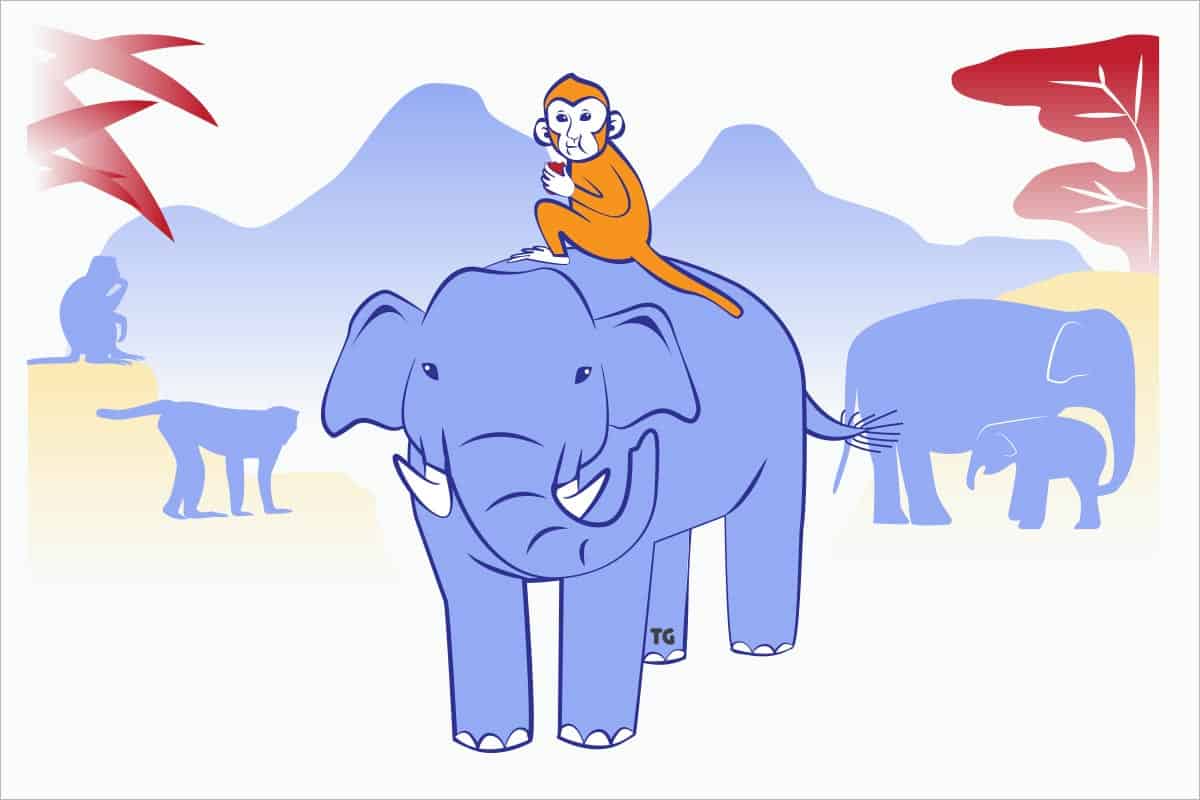Ecotourism (including nature-based and wildlife-based tourism) is considered the fastest-growing market in the tourism industry. And Thailand is one of the top ecotourism destinations to experience nature and spot wildlife animals. A trip there will guarantee unique encounters with unmistakable biodiversity. Thailand is a relatively small country, but its nature and wildlife are incredibly diverse.
The country’s landscape with various kinds of tropical forests provides terrestrial and aquatic habitats for several species in complex ecosystems. Given its biodiversity, it is no surprise that Thailand is home to more than 10% of the world’s animals (1).
Thailand’s wild animals range from large to more minor bugs and birds, comprising approximately 6-10% of the total species known thus far (2). Most of them have found refuge in Thailand’s protected national parks, while some can be seen roaming all over the country.
Although nature and wildlife all contribute to its national identity, have you ever wondered why elephants and monkeys are the first to come to mind when thinking about Thailand native animals?
This article will examine what makes wild elephants and monkeys so embedded in Thai culture and why each one has become so symbolic as a national animal in Thailand. We will also provide you with the best places to find them, so you are well prepared to pinpoint and discover these iconic animals of Thailand during your next visit.
Elephants in Thailand
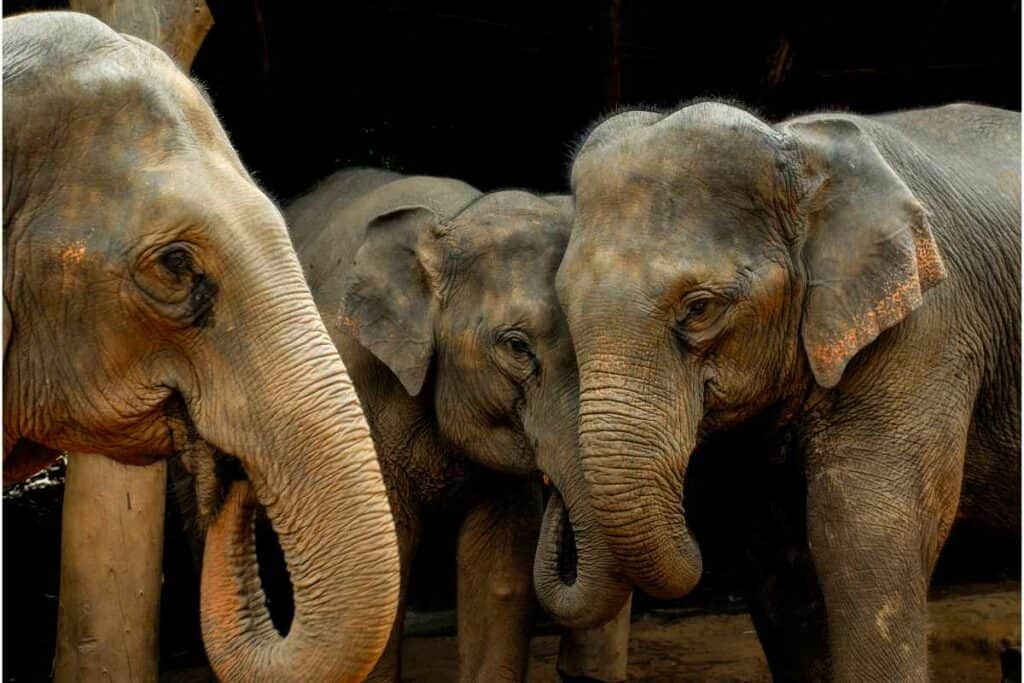
Elephants are not only the world’s largest terrestrial mammals, but they are also one of the most intelligent creatures with highly sensitive, complex emotions, self-awareness, and caring senses.
On top of being a fascinating species, wild elephants in Thailand actually benefit other lives as important ecosystem engineers. They help maintain the biodiversity of the ecosystems for other species where they live. More importantly, they are also part of the tourist attractions in the modern world that bring large amounts of money to the local community.
Background of Thai Elephants and Their Protection
Thai elephants have been recognized as national symbols of Thailand for centuries. They are subspecies of the Indian elephants, Elephas maximus indicus, which is also found in Malaysia and Sumatra (3).
Before the 1900s, wild elephants in Thailand were abundant, with approximately 300,000. There was also an estimated 100,000 domestic elephants (4). However, the population dropped significantly by the 1980s due to the threats to wild elephants, such as habitat loss and degradation, agricultural encroachment, ivory poaching (5). Plus, human-elephant conflict (HEC) (which is seen as the most severe threat to elephants) was found in 41 Protected Areas (22%) (6).
The first Wild Elephant Protection Act was enacted in 1900 and revised in 1960. Later, wild elephants in Thailand were listed as “Preserved Animals” in the Wildlife Conservation and Protection Act 1992 and in 2019 by the Department of National Park, Wildlife and Plant Conservation.
They are classified as “endangered” species in the Thailand Red Data 2005, in the IUCN Red List 2012 (3). List Number 1 (Appendix I) of the CITES states that any part of an elephant cannot be purchased unless the research or reproduction permit is allowed from an importing country. Their ivory is also protected by the Elephant Ivory Tusks Act 2015, which stipulates that the killing, hunting, collecting, or reproduction of any elephant parts are prohibited unless the permits are allowed (5).
Moreover, domestic elephants (approximately 3,500) are also protected by the Beasts of Burden Act 1939 under the Department of Provincial Administration, Ministry of Interior. The owners of the elephants have to register their elephants to prevent wild elephant smuggling, which will help in elephant policy, elephant welfare, and camp management (5).
In recent interesting action, the Thai government has drafted a law that requires every domestic elephant birth to be registered. The elephant is given an ID card. They also issue instructions to collect DNA samples from every domesticated elephant in the Kingdom to build a comprehensive database containing their genetic information (7).
With this, many elephant conservation measures to lessen the human-elephant conflict have been established. This has led to the establishment of several projects, such as strengthening law enforcement, controlling ivory stockpiles, establishing and strengthening the borders of protected reserves, and anti-poaching patrols. Also, preventative methodologies to reduce human-elephant conflicts by using the concept of forest fragmentation, habitat linkage, the ecological function of the corridor, landscape connectivity, etc.
Interestingly, since then, the population of wild elephants in Thailand has increased in every area. Recent surveys report approximately 3,126 – 3,341 wild elephants in 38 National Parks, 31 Thailand Wildlife Sanctuaries, and 69 Protected Areas covering a total area of 52,000 km2 or 30% of Thailand’s Protected Areas (8).
Elephants in Thai Culture
Elephants have been a part of the fabric of daily life in Thailand. They are featured in Thai culture and have influenced the development of folklore and integrated into Thais’ beliefs, lifeways, and history. They have been recognized as a symbol of national identity for centuries.
Here are the different roles of elephants in Thai culture have held over the years (3):
Elephants as Means of Transportation:
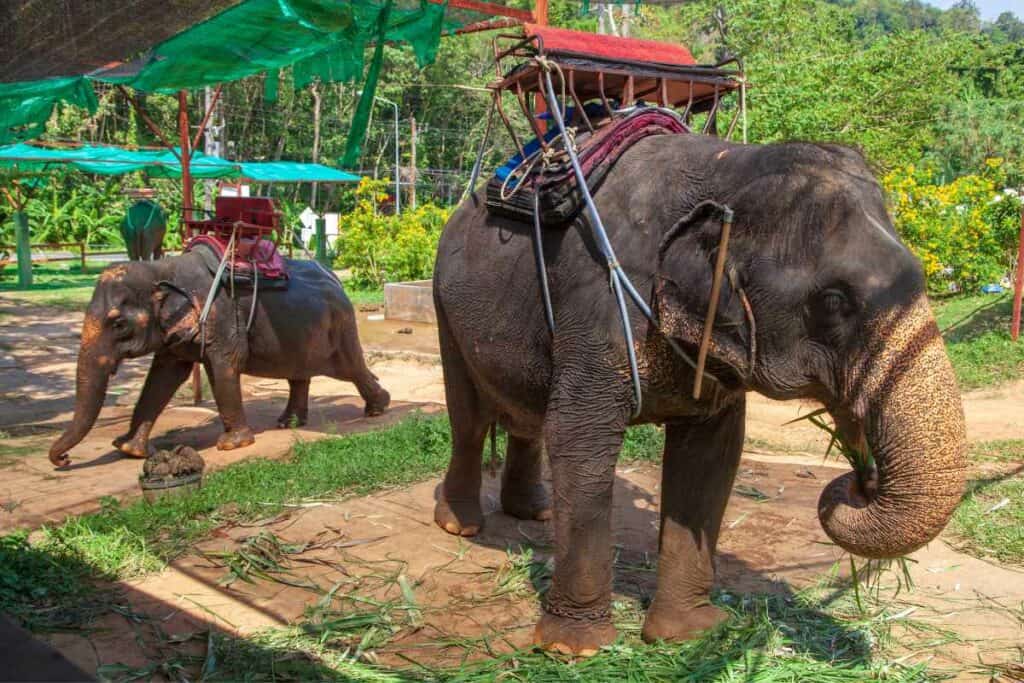
In Thailand, elephants were once served primarily as a means of transportation. They were used to trek through the dense forests from the city to the city. They also were used to transport goods along the Silk Road or other ancient networks for trading because their size and strength could be carried lots of goods at one particular time (3).
Elephant Battles:
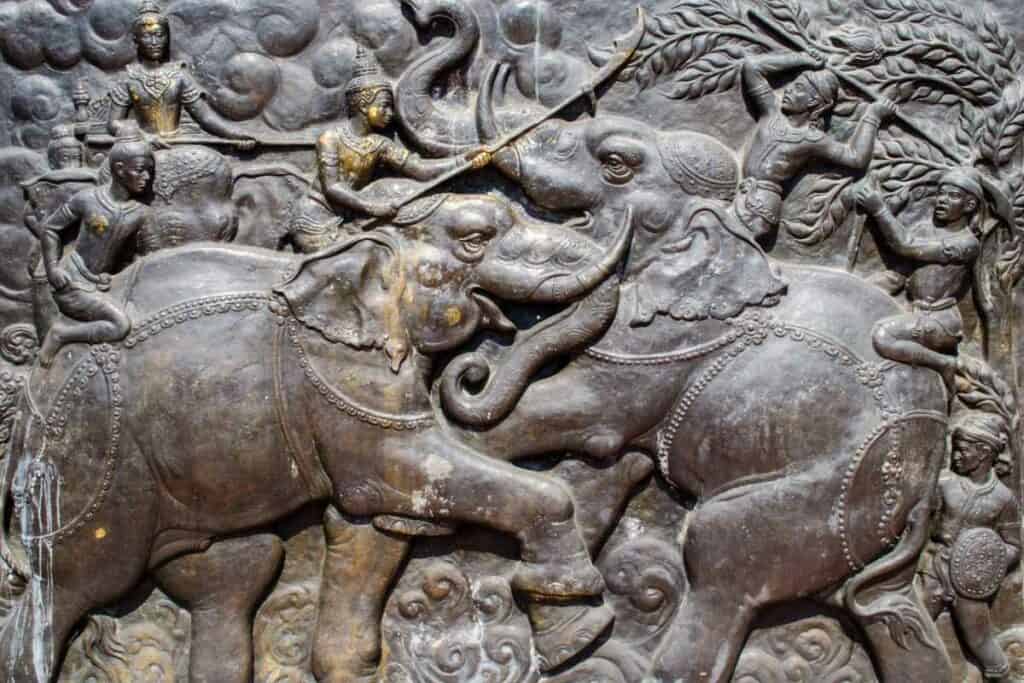
Elephants were used as instruments of war in Thailand because they were the historical equivalent of a tank. With a speed of 25 kilometers per hour, they were feared on the battlefield. One of the first depictions of the Thai military unit complete with war elephants occurs on a mural at Angkor Wat, Cambodia.
Another one of Thailand’s most well-known elephant battles occurred during the Ayutthaya period in 1593 when King Naresuan fought against Crown Prince Mingyi Swa from the Toungoo Empire. Interestingly, in the past, elephants during wartime were used not only because they have a gigantic size but also because they believed using elephants would bring victory.
The Use of Elephants in Industry and Agriculture:
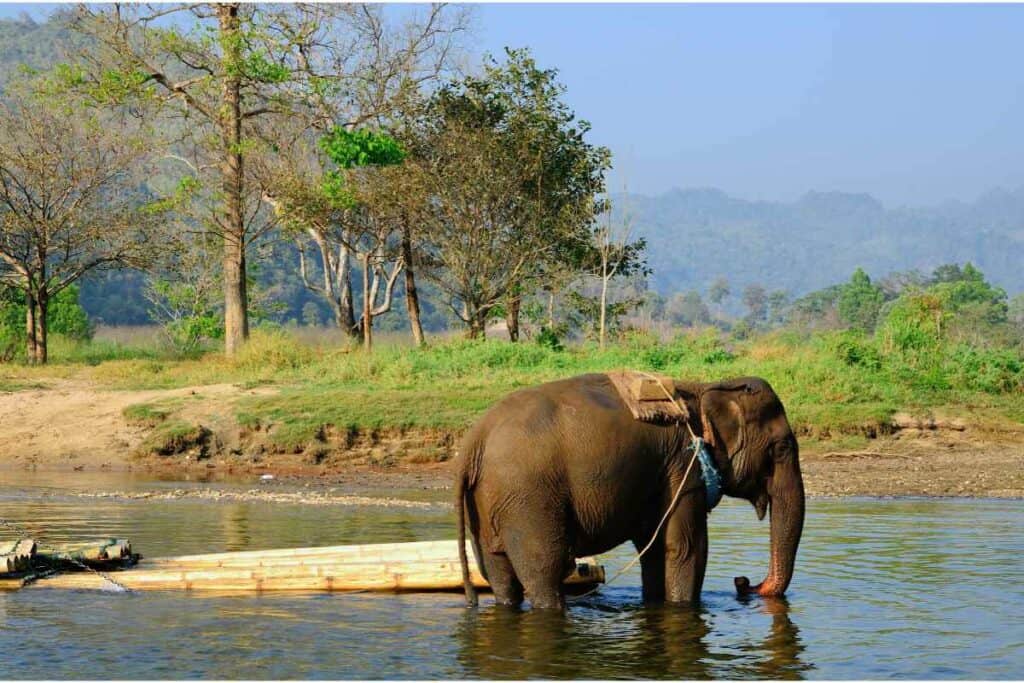
During the 20th century, elephants in Thailand played an important role in industries, especially the timber and logging industry. These huge creatures could drag heavy logs from deep within dense forests without damaging the small trees. They were also once used as agricultural animals to help farmers with heavy labor and transportation without the need for road construction (3).
Elephants as the Symbol of Sanctity in Buddhism:
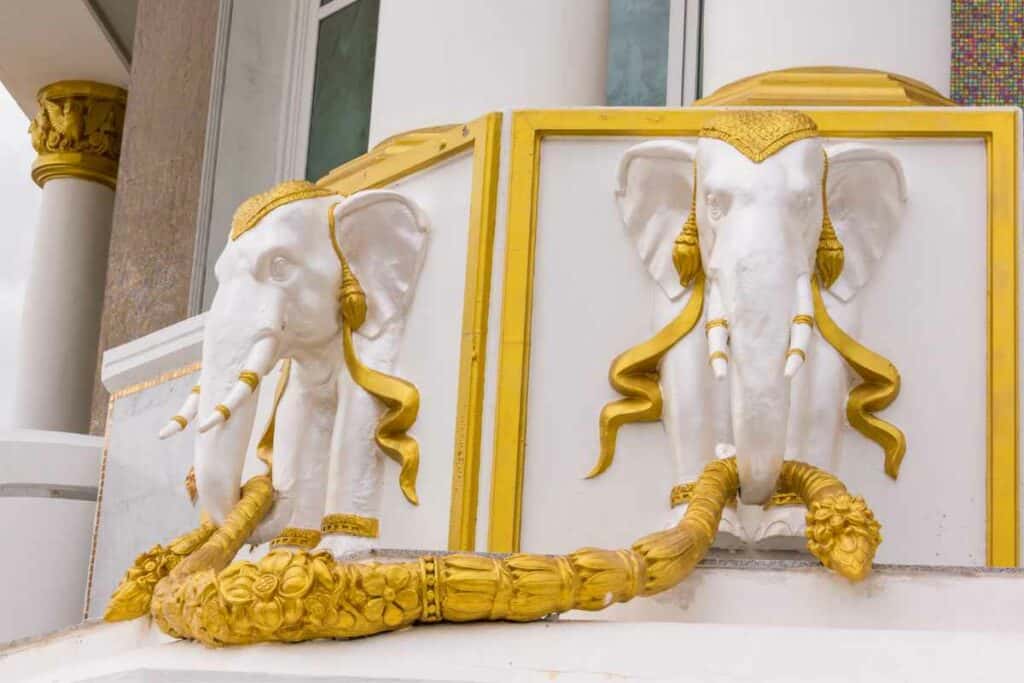
Elephants often appear in Buddhist sites because Buddhism believes that the elephant is an auspicious symbol of excellence and divinity, as manifested in Bodhisattva, an allegory about Buddha’s past lives and a sacred symbol traditionally bringing good luck.
Many Thai temples have wall paintings, murals, statues, or pagodas of elephants, such as the war elephant battle scenes at Wat Arun in Bangkok and the elephant statues or the elephant–based pagodas at Wat Chang Lom in Sukhothai (9).
Elephants as the Symbol of Royalty:
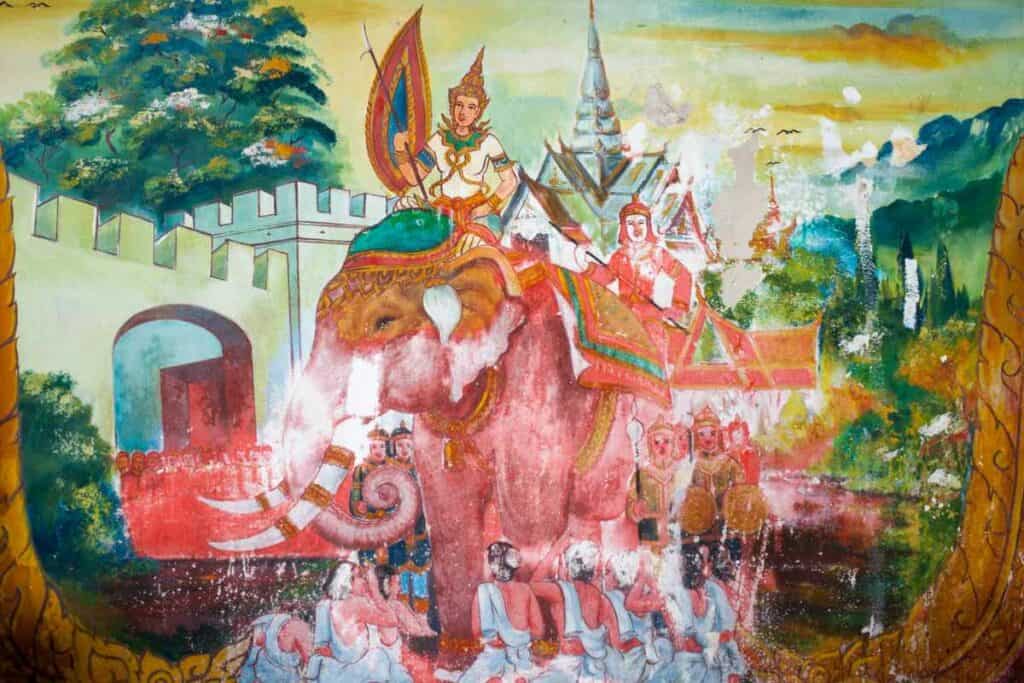
Since the 13th century (Sukhothai period), white elephants have symbolized the royal or kingship and held a lofty status in Thailand (9). In Thai myth, the white elephant is the most sacred of all creatures, symbolizing the royal family’s power.
In Buddhist legend, they represent power, wealth, spreads auspiciousness, a gathering of wisdom and purity, and a symbol of fertility. Thus, white elephants have been used in royal ceremonies until now because of their revered status, such as the royal coronation ceremony of the king (3).
Elephants in the National Flag:
Before the Rattanakosin period, the first Siam flag was probably a plain red one, first established around 1656 – 1688. In the reign of King Rama I, a white chakra was added to the red flag and used exclusively on royal ships, while commoners continued to use the plain red flag.
Later, King Rama II demanded that Siam use “Three White Elephants” at the center of the chakra in the red background flag. Then officially, the first flag was created during the reign of King Rama IV, showing a white elephant on red ground, as the plain colored flag was not distinct enough for international relations. Since then, the white elephant flag was printed on many items, and it became the well–known symbol of Siam (12).
Due to the significant roles of elephants in Thai culture, Thailand has arranged the 13th March of every year to be the “Thailand Elephant Day” to raise awareness and realize the value and importance of elephants and call for conservation support for Thai elephants (3).
Where to Spot Elephants in Thailand
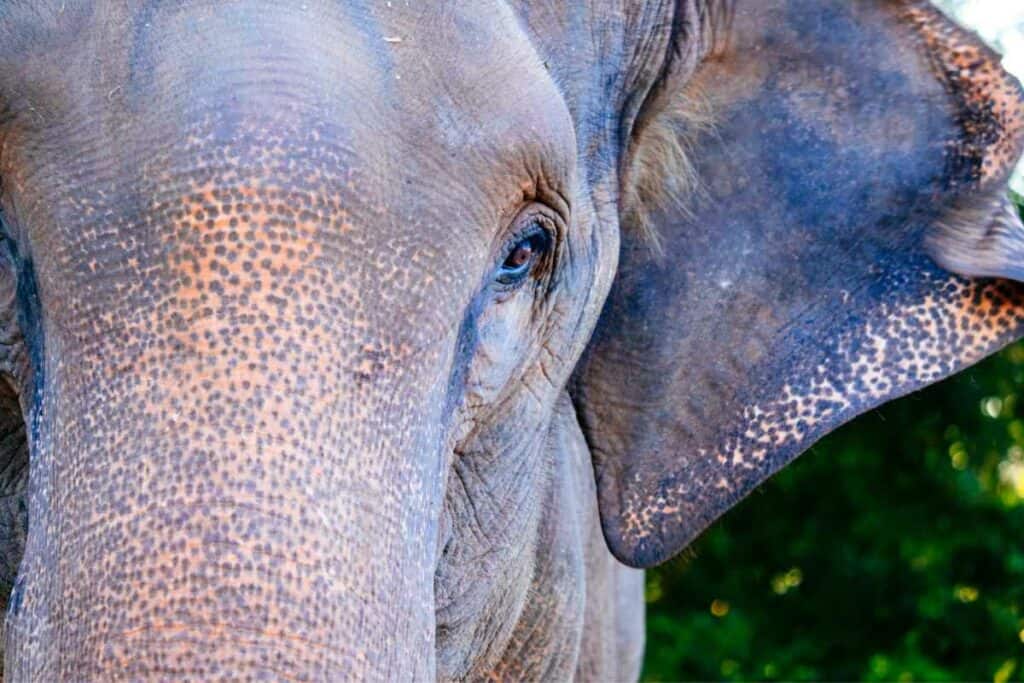
Wild Elephants:
If you are looking for the wild elephant experience in Thailand, you need to visit certain preserved areas and national parks.
These are key places where you can find wild elephants:
- Western Forest Complex
- Kaeng Kranchan Forest Complex: Kui Buri National Park
- Dong Phayayen – Khao Yai Forest Complex: Khao Yai National Park
- Phu Khiao – Nam Nao Forest Complex: Phu Luang Preserved Area and Nam Nao National Park
- Eastern Forest Complex
- Khlong Saeng – Khao Sok Forest Complex: Khao Sok National Park
- Northern Forest Complex: Omkoi – Mae Tuen (3)
Domestic Elephants:
If you desire to get up close and interact with domestic elephants, many elephant learning centers are established by local communities, government centers, private sectors, and travel agencies. For example:
- The Thai Elephant Conservation Centre (TTEC) in Lampang
- Mae Taeng Elephant Camp and Mae Sa Elephant Camp in Chiang Mai
- Surin Elephant Village in Surin
- Sai Yok Elephant Village and Taweechai Elephant Camp in Kanchanaburi
- Pattaya Elephant Village in Chon Buri
- The Elephant Jungle Sanctuary (EJS) in Chiang Mai, Phuket, Chonburi, and Samui
- Sappraiwan Elephant Sanctuary in Phitsanulok
In addition, because the elephant is the national symbol of Thailand, they are the main attraction in many festivals and events. Such as Songkran Festival held in Ayutthaya, where you can join in and splash water with elephants.
5 Things to Remember When Around Wild Elephants
There are cases where elephants have harmed people. Vehicles are prone to attack from wild elephants foraging in the forest or even bull elephants during musth. If elephants attack you, they will often keep stomping until you die.
So, here are some important tips on what to do when around wild elephants, as well as the warning signs if you find yourself in dangerous situations (that are even more prudent to avoid) (3, 10, 11):
- Keep the distance from a herd of elephants and give them enough space.
- Do not approach or touch a baby elephant.
- Keep food away because it might entice a hungry elephant to come too close.
- Read the body language or signals of elephants and recognize if they are about to charge. If it is a bluff or mock charge – stay calm, stand still, do not turn your back, be non-threatening, or keep shouting loudly for as long as it takes for the elephant to leave the area. If it is a real charge, run in a zigzag pattern, climb up a sturdy enough tree or rock of good height, hop into a narrow ditch, or throw a decoy object away to distract the elephant.
- When driving, move the vehicle slowly in the reverse direction and do not blow the horn.
Monkeys in Thailand
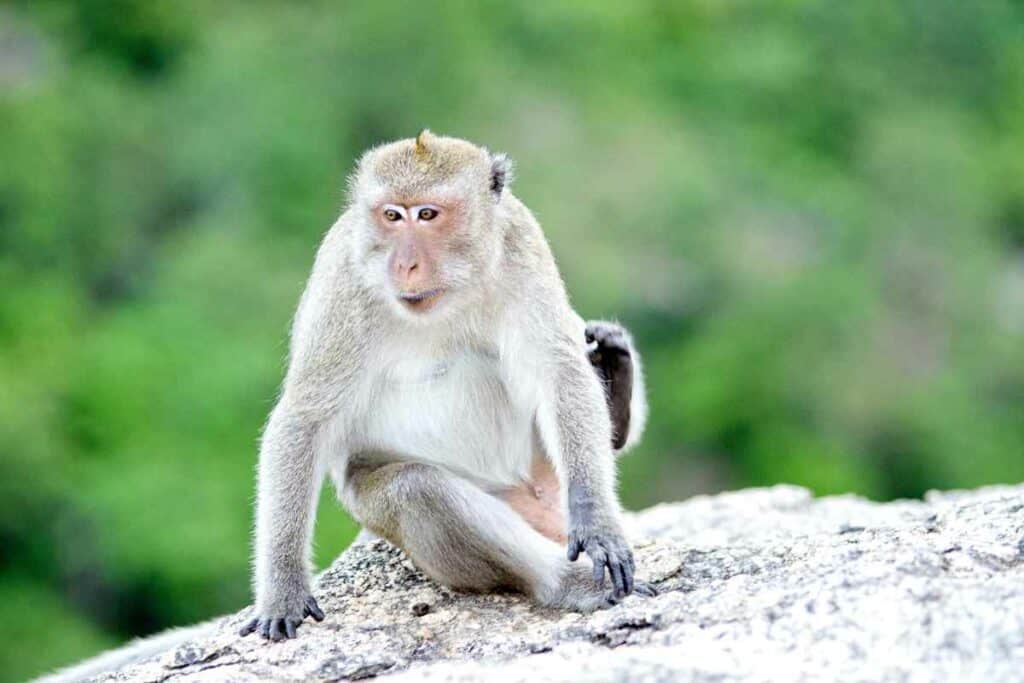
Thousands of pictures showing a considerable number of monkeys sitting and walking along the streets in Thailand are very familiar. But do you know how many types of monkeys in Thailand are there?
The commonest of all wild primates or monkeys in Thailand are the macaques. They are considered highly intelligent but may be perceived as bad-tempered as adults.
Many tourists who have come into contact or feed habituated semi–Thailand wild animals often receive serious bites, as they can be vicious. But truly, wild monkeys are much shyer and avoid human contact (13). These Thailand monkeys species live in troops of varying sizes and live in forests, on plains, or among cliffs and rocky terrain.
However, these days, some macaques live near or even within cities. Some live in steep limestone hills and cliffs near human settlements. Some usually can be seen close to Buddhist temples, where they have become habituated, or at roadside food hangouts in some national parks and preserved areas.
6 Types of Monkeys in Thailand
Despite Thailand’s large population of monkeys, only six species can be found (14):
1. The Long-Tailed Macaque
The long-tailed macaque, also known as the crab-eating macaque or “ลิงแสม” (Scientific name: Macaca fascicularis), is native to mainland Southeast Asia. This macaque can live in various habitats, including rainforests, shrubland, and riverine and coastal forests (15, 16).
They also easily adjust to human settlements. So they have been alternately seen as agricultural pests, a known invasive species, and a threat to biodiversity in several locations. They are omnivores, eating a variety of animals and plants.
In Thailand, they are probably the most commonly seen species found throughout the country. Interestingly, it reports that they can use stone tools to open nuts, oysters, other bivalves, and various types of sea snails along the Andaman Sea coast and offshore islands. Another instance of tool use is washing and rubbing foods before consumption.
2. The Northern Pig-Tailed Macaque
The northern pig-tailed macaque, or “ลิงกัง” or “ลิงกังเหนือ” (Scientific name: Macaca leonina), is a species of macaque in the family Cercopithecidae that can be found in Bangladesh, Cambodia, China, India, Laos, Myanmar, Thailand, and Vietnam (15, 17).
Traditionally, the northern pig-tailed macaque was considered a subspecies of the southern pig-tailed macaque but is now classified as individual species. In Thailand, it can be found in many locations throughout northern and central Thailand, south to Chumporn. They are the most common well-known monkey in Khao Yai National Park, as they tend to sit by the road waiting for tourists to feed them.
3. The Southern Pig-Tailed Macaque
The southern pig-tailed macaque, or “ลิงกัง” or “ลิงกังใต้” (Scientific name: Macaca nemestrina), is a medium-sized monkey and very similar to the northern pig-tailed macaque. Still, they are recognized as separate species (15, 18).
They are mainly terrestrial but also skilled climbers, primarily found in rainforests. They are omnivorous, eating mainly fruits, seeds, berries, cereals, fungi, and invertebrates. They live in the southern half of the Malay Peninsula, Borneo, Sumatra, and Bangka Island. In Thailand, it can be found south of Surat Thani, such as Khao Luang National Park. They also are well-known as domestic monkeys for harvesting coconuts in Thailand.
4. The Rhesus Macaque (Macaca mulatta)
The rhesus macaque, or “ลิงวอก” (Scientific name: Macaca mulatta), is listed in the IUCN Red List of “Threatened Species.” They are native to South Asia, Central Asia, and Southeast Asia that live in the broadest geographic range, from grasslands to arid and forested areas. But also close to human settlements (15, 19).
They are diurnal animals in arboreal and terrestrial and are mostly herbivorous, eating mainly fruit. But also eat seeds, roots, buds, bark, and cereals. They also have specialized pouch-like cheeks, allowing them to hoard their food temporarily. In Thailand, they are the rarest of all macaques and are locally classified as endangered. It can be found in just three areas in Thailand: Huai Kha Khaeng, Phu Khiao, and Thung Yai Naresuan.
5. The Assamese Macaque
The Assam macaque or Assamese macaque, or “ลิงอ้ายเงี๊ยะ” (Scientific name: Macaca assamensis), is listed in CITES Appendix II, which is legally protected in all countries of occurrence, and listed as “near threatened” by the IUCN (15, 20).
They are native to South and Southeast Asia, living in tropical and subtropical semi-evergreen forests, dry deciduous and montane forests. They are diurnal and live both arboreal and terrestrial. They are omnivorous and feed on fruits, leaves, invertebrates, and cereals. In Thailand, it can be found in the wild at Doi Suthep-Pui National Park, Huay Kha Khaeng Wildlife Sanctuary, and Phu Khiao Wildlife Sanctuary.
6. The Stump – Tailed Macaque
The stump-tailed macaque, or “ลิงเสม” (Scientific name: Macaca arctoides) and also called the bear macaque, is a species of macaque found in South Asia (15, 21).
They are probably the fiercest of the Thailand monkey species, living in subtropical and tropical broadleaf evergreen forests but not found in dry forests. They are terrestrial creatures foraging for food on the ground, eating many vegetation types, such as seeds, leaves, and roots, and hunting freshwater crabs, frogs, bird eggs, and insects.
Nowadays, stump-tailed macaques are rare in the wild, a few found in preserved areas. In Thailand, it can be located in the western parts of the country: Kaeng Krachan National Park, Kui Buri National Park, Huai Kha Khaeng Wildlife Sanctuary, Khao Sok National Park, etc.
Monkeys in Thai Culture
Although monkeys or macaque are not as important as Thai elephants, they are one of the most common that has become one of the unique animals of Thailand, especially around Buddhist temples and national parks. Despite their habits causing problems to many people nowadays, monkeys have also long been a part of Thai culture.
Monkeys in Thai Literature and Arts:
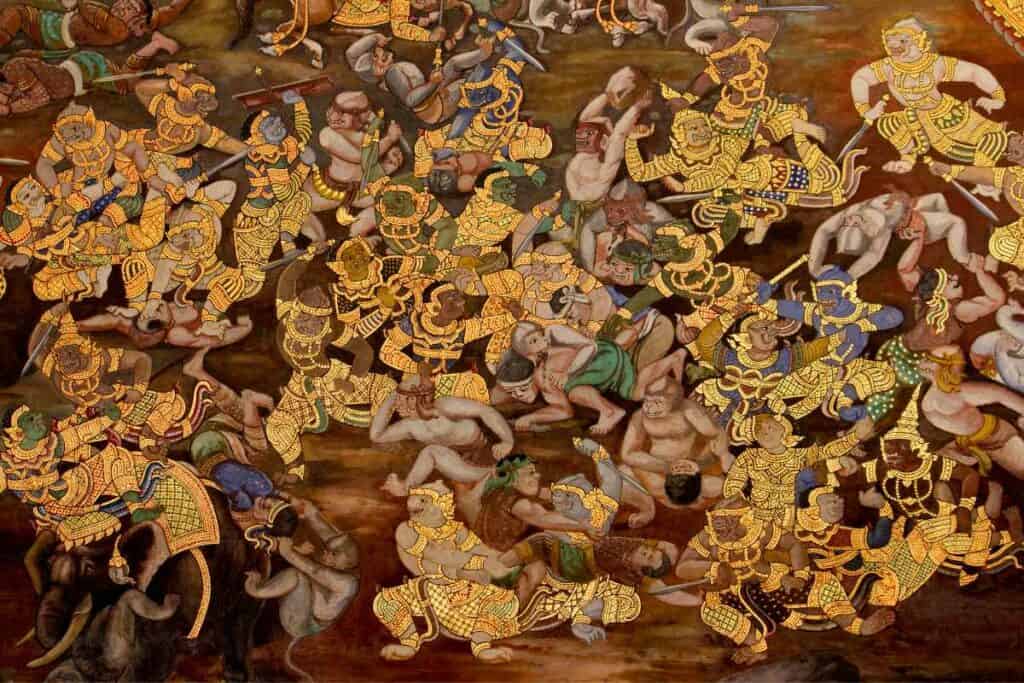
Monkey characters have appeared in the literature, art, and drama in Thai culture for a long time due to the Thai national epic “Ramakien (รามเกียรติ์),” which is derived from the Hindu Ramayana.
In this epic, the best-known monkey god characters are the monkey warriors named “Hanuman,” “Sugriva,” “Angada,” and “Vali.” These characters are also common to be seen in murals and wall paintings of Thai Buddhist temples, as well as the famous dance drama genre from Thailand known as “Khon (โขน).” (22)
Monkeys in Buddhism:
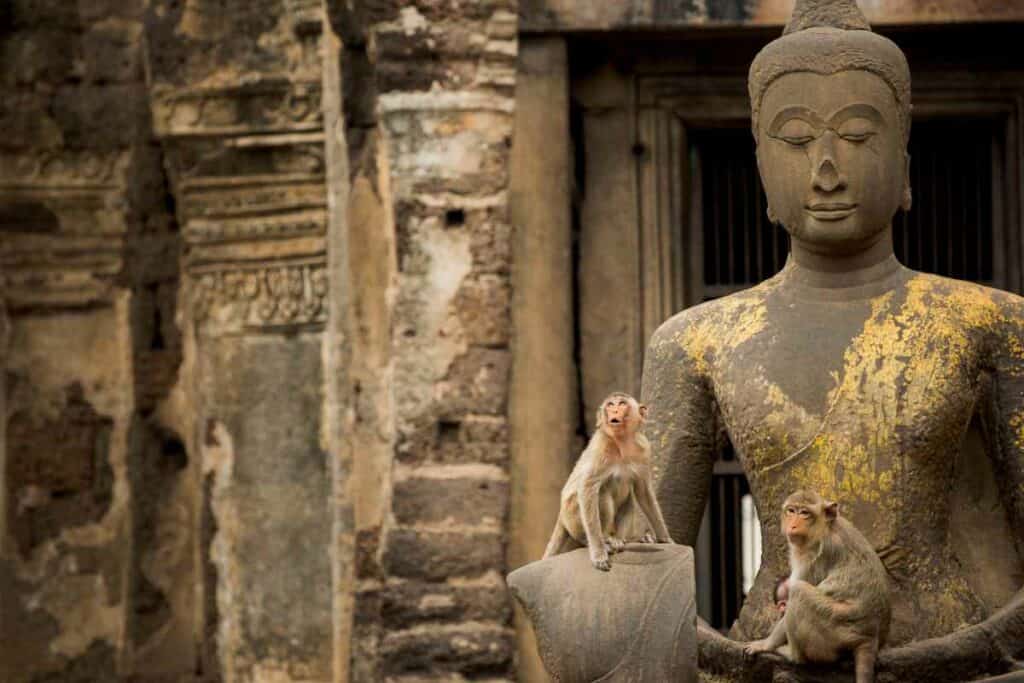
In one episode in the Buddha’s life, he spent a rained retreat at the Palilaya forest by himself without monks or people in attendance. He had an elephant and a monkey as attendants. The story is about the elephant (known as Palilayaka) who attended to Buddha and brought fruits from the forest to offer him.
When the monkey saw the elephant brought a honeycomb, the Buddha received it but did not drink it. Then the monkey considered the honeycomb and saw bee larvae inside. He took them all out and then took only the pure honey to offer the Buddha.
This time the Buddha drank the honey. The monkey watched him from a tree and was overjoyed. Suddenly, jumping with excitement, he fell from the tree and was killed by a sharp tree stump. After dying, the monkey was reborn as devas in the Tavatimsa heaven (23). Moreover, there are many more stories about monkeys in Buddhism, and they also represent the mental process or a symbol of the journey toward Buddhist enlightenment.
The Use of Monkey Labor in Agriculture:
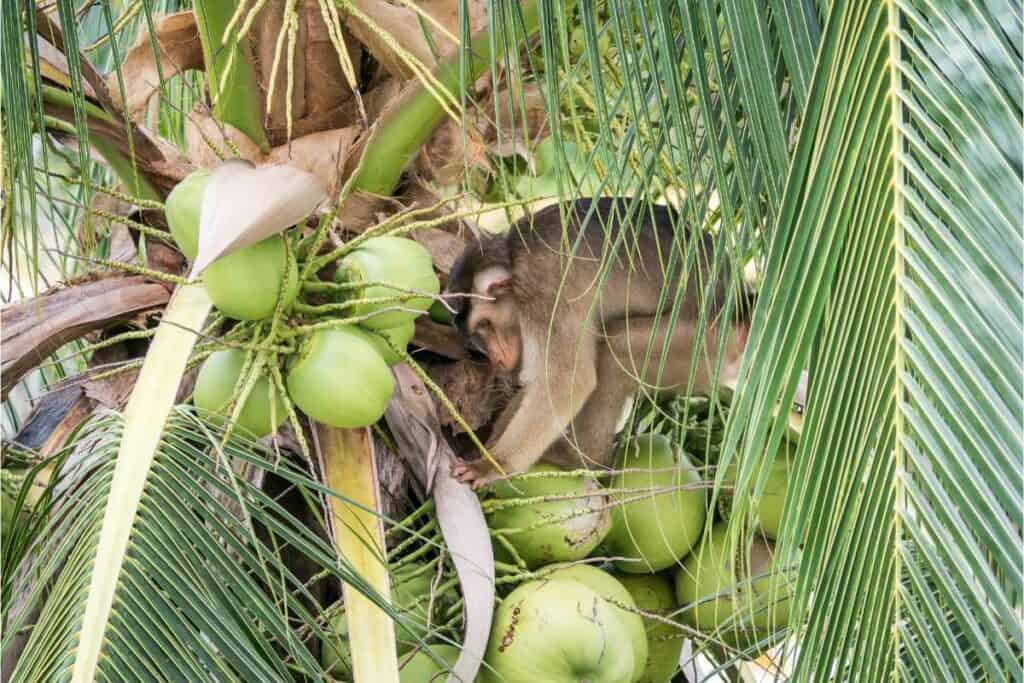
In certain areas, some monkey species are considered agricultural pests that can threaten biodiversity and cause extensive damage to commercial and subsistence crops.
However, some monkeys can be domesticated and used as agricultural machines to add more value to the economy. For example, social media has recently drawn attention to the use of monkey labor in Thailand relating to coconut harvesting (24). Many people have called for it to be boycotted deeming that monkeys are forced to pick coconuts. However, figures in Thailand have denied monkey abuse.
Whether it is considered abuse or not, these monkeys have been trained to harvest coconuts from palm trees since some trees are too high for humans to climb. They are also treated like family members and are punished or rewarded when deemed necessary. Thus, monkey training is a kind of folk wisdom passed down for generations for more than a hundred years (25, 26, 27), showing the human-animal bond as a mutually beneficial and dynamic relationship.
The 9 Best Place to See Monkeys in Thailand
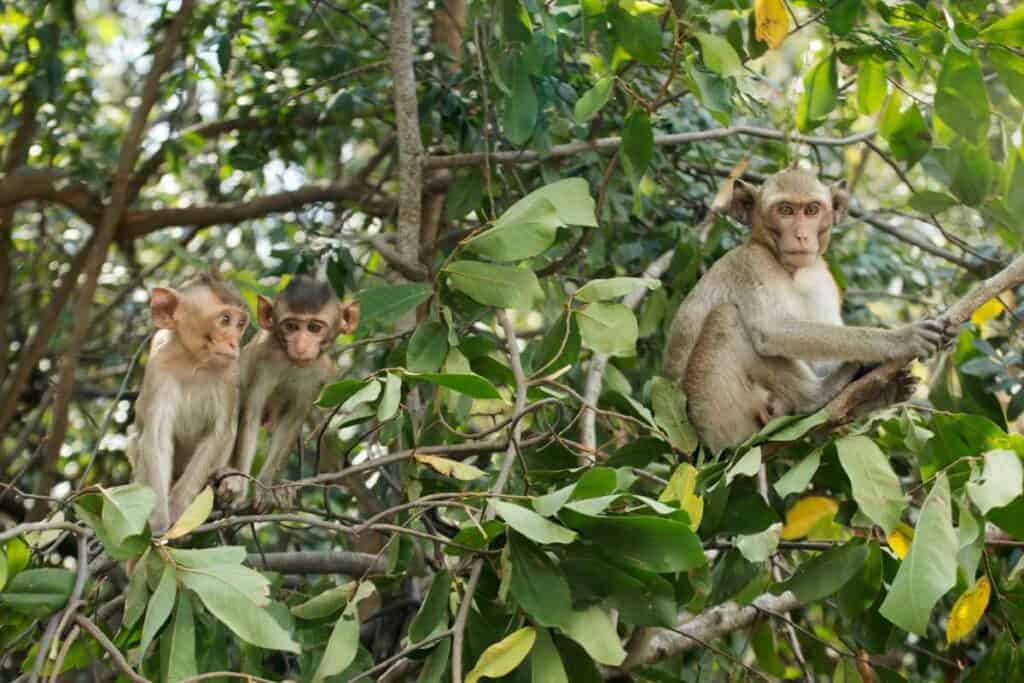
If you want to experience these types of monkeys in Thailand, here are well-known places where you can see them:
- Khao Yai National Park
- Erawan National Park
- Khao Sam Muk in Chonburi
- Phra Prang Sam Yot in Lopburi
- Phra Nakhon Khiri (Khao Wang) in Phetchaburi
- Monkey Hill in Phuket
- Tiger Cave Temple in Krabi
- Koh Phi Phi
- Koh Chang
Conclusion
Thailand is one of the best ecotourism destinations to experience nature and wildlife, especially elephants and monkeys. These two iconic Thai animals are not just animals, but they also have played a significant role in the lives of Thai people. They are sources of inspiration in different cultural activities, such as belief, art, literature, and wisdom.
When you start coming into contact with these captivating animals in Thailand, you will learn and understand the natives’ relationships with them, which are deeply rooted within the country’s history!
Like always, if you want to discover more about Thailand, stay guided with ThaiGuider. You might learn something you never knew about this unique country.
References
1. PBS. A Bounty Of Life. PBS. [Online] [Cited: January 29, 2022.] https://www.pbs.org/edens/thailand/bounty.htm/.
2. Biodiversity In Thailand. Baimai, Visut. The Journal Of The Royal Institute Of Thailand, 2010, Vol. II.
3. สำนักอนุรักษ์สัตว์ป่า กรมอุทยานแห่งชาติ สัตว์ป่า และพันธุ์พืช. คู่มือ ความรู้เรื่องช้าง. s.l. : สำนักอนุรักษ์สัตว์ป่า กรมอุทยานแห่งชาติ สัตว์ป่า และพันธุ์พืช, 2017.
4. EleAid. Elephants in Thailand. EleAid. [Online] [Cited: January 29, 2022.] http://www.eleaid.com/country-profiles/elephants-thailand/.
5. Human Elelphant Voices. ช้างป่าในประเทศไทย. Human Elelphant Voices. [Online] [Cited: January 29, 2022.] https://humanelephantvoices.org/elephants-thailand/.
6. Human Elephant Voices. ความขัดแย้งระหว่างคนกับช้างป่าในประเทศไทย. Human Elephant Voices. [Online] [Cited: January 29, 2022.] https://humanelephantvoices.org/humans-and-elephants/.
7. Royal Thai Embassy, Washington D.C. Government Steps Up Efforts To Protect Thai Elephants. Royal Thai Embassy, Washington D.C. [Online] [Cited: January 29, 2022.] https://thaiembdc.org/2018/03/19/government-steps-up-efforts-to-protect-thai-elephants/.
8. ทรงธรรม สุขสว่าง และทวี หนูทอง. ศาสตร์และศิลป์ การจัดการทรัพยากรสัตว์ป่าในพื้นที่คุ้มครอง. s.l. : กรุงเทพฯ: กรมอุทยานแห่งชาติ สัตว์ป่า และพันธุ์พืช, 2017.
9. The Study Of Thai Elephant Culture Based On The “Elephant Metaphors” In Thai Idioms. Han, Jianghua. Comparative Literature: East & West, 2019, Vol. 3:2.
10. wikiHow Staff. How To Survive A Charging Elephant. wikiHow. [Online] March 21, 2021. https://www.wikihow.com/Survive-a-Charging-Elephant/.
11. Nelson, Rob. How To Survive An Elephant Attack. StoneAgeMan. [Online] [Cited: January 29, 2022.] https://stoneageman.com/how-to-survive-an-elephant-attack/.
12. Google Arts & Culture. The Thai National Flag. Google Arts & Culture. [Online] [Cited: January 29, 2022.] https://artsandculture.google.com/exhibit/the-thai-national-flag-thai-flag-museum/wgLisXE4iMuHIg?hl=en/.
13. Bruce. Thailand’s Primates: Terrestrial And Arboreal Mammals. brucekekule. [Online] September 26, 2011. http://brucekekule.com/wild_species_report/thailands-primates-terrestrial-and-arboreal-mammals/.
14. และพันธุ์พืช, กลุ่มงานวิจัยสัตว์ป่า สำนักอนุรักษ์สัตว์ป่า กรมอุทยานแห่งชาติ สัตว์ป่า. คู่มือสำรวจประชากรลิง สถานการณ์ และแนวทางการจัดการปัญหาลิงในพื้นที่ชุมชน. DNP. [Online] [Cited: January 29, 2022.] https://www.dnp.go.th/wildlife/technique_document/คู่มือสำรวจประชากรลิงสถานการณ์แลtแนวทางการจัดการปัญหาลิงในพื้นที่ชุมชน.pdf.
15. Thompson, Paul. Macaques Of Thailand . Wildlife Thailand. [Online] September 11, 2018. https://wildlifethailand.com/blog-posts/mammals/292-macaques-of-thailand/.
16. Raffles, Thomas Stamford. Crab-eating Macaque. Thai National Parks. [Online] 1821. [Cited: January 29, 2022.] https://www.thainationalparks.com/species/crab-eating-macaque/.
17. Blyth, Edward. Northern Pig-tailed Macaque. Thai National Parks. [Online] 1863. [Cited: January 29, 2022.] https://www.thainationalparks.com/species/northern-pig-tailed-macaque/.
18. Linnaeus, Carolus. Southern Pig-tailed Macaque. Thai National Parks. [Online] 1766. [Cited: January 29, 2022.] https://www.thainationalparks.com/species/southern-pig-tailed-macaque/.
19. Zimmermann, Eberhard August Wilhelm von. Rhesus Macaque. Thai National Park. [Online] 1780. [Cited: January 29, 2022.] https://www.thainationalparks.com/species/rhesus-macaque/.
20. McClelland, John. Assam Macaque. Thai National Parks. [Online] 1840. [Cited: January 29, 2022.] https://www.thainationalparks.com/species/assam-macaque/.
21. Saint-Hilaire, Isidore Geoffroy. Stump-tailed Macaque. Thai National Parks. [Online] 1831. [Cited: January 29, 2022.] https://www.thainationalparks.com/species/stump-tailed-macaque/.
22. ศิลปวัฒนธรรมโขน. ประวัติความเป็นมา. ศิลปวัฒนธรรมโขน. [Online] [Cited: January 29, 2022.] https://sites.google.com/site/khon5752/pra-w-1/.
23. สมุดภาพพระพุทธประวัติ. ภาพที่ ๖๖ ครั้งหนึ่งเสด็จไปจำพรรษา ณ ป่าปาเลไล โดยมีช้างกับลิง เป็นพุทธอุปัฏฐาก. 84000. [Online] [Cited: January 29, 2022.] https://84000.org/tipitaka/picture/f66.html/ .
24. Fobar, Rachel. Monkeys Still Forced To Pick Coconuts In Thailand Despite Controversy. National Geographic. [Online] February 19, 2021. https://www.nationalgeographic.com/animals/article/monkey-labor-continues-in-thailands-coconut-market/.
25. The Nation. This Monkey Doesn’t Just Pick Coconuts. The National Thailand. [Online] July 09, 2020. https://www.nationthailand.com/in-focus/30391021/.
26. ชัยยศ ยงค์เจริญชัย. การใช้ลิงขึ้นมะพร้าว ภูมิปัญญาตามวิถีชาวบ้านหรือการทรมานสัตว์. BBC Thailand. [Online] August 14, 2020. https://www.bbc.com/thai/thailand-53763690/.
27. โชคจรัสกุล, กนกพร. ‘ลิงเก็บมะพร้าว’ เพื่อนเกลอของชาวสวน. กรุงเทพธุรกิจ มีเดีย. [Online] July 9, 2020. https://www.bangkokbiznews.com/social/888496/.
THINKING ABOUT A TRIP TO THAILAND?
I am working on a FREE Thailand Travel Guide with a FULL 7 Day Itinerary. Be the first to receive it!
Thank you for signing up.
Something went wrong.
